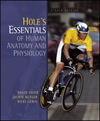 |  Hole's Essentials of Human Anatomy & Physiology, 8/e David N. Shier,
Washtenaw Community College
Jackie L. Butler,
Grayson County College
Ricki Lewis,
SUNY - Albany
PrefaceI. Introduction and rationale
In this eighth edition of Hole's Essentials of Human Anatomy and Physiology we continue our
commitment to introduce the structure and function of the human body in an interesting and
highly readable manner. We have added content only when it can be integrated into the larger
concept of homeostasis and maintenance of the internal environment. Indeed, a book at this
level is almost a metaphor of the human body itself—nothing unnecessary is retained, and every
component contributes to the final purpose.
Given the immensely varied population of most universities and colleges, particularly two-year
and community colleges, we have continued to devote top priority to the readability of this text.
Our challenge has been to do so while at the same time responding to requests to enhance
physiology coverage. We have accomplished this through thoughtful changes in the text and art,
carefully designed and implemented pedagogical features, and a wide choice of ancillaries
designed to review and augment both in-class and out-of-class student activities.
II. Intended audience
The level is geared toward students in one-semester courses in anatomy and physiology who
are pursuing careers in allied health fields and who have minimal background in physical and
biological sciences. The first four chapters cover the chemistry and cell physiology necessary to
understand biological processes. Students who have studied this material previously will view it
as a welcomed review, but newcomers will not find it intimidating. We avoid unnecessary detail
and concepts throughout.
III. General ThemesCommitment to Readability
Even the most basic concepts of human anatomy and physiology can be challenging to the
uninitiated, and most of the students in introductory anatomy and physiology courses fall into this
category. Students and instructors both are faced with an enormous amount of material to
cover in a short period of time. Our approach is to never add unnecessary content, and to
maintain readability as our top priority.
Clear Application of Concepts
The content carefully balances structure and function to provide an integrated view of how the
human body works. In striking this balance we recognize a clear trend toward a greater
emphasis on physiology across the board in the health care professions. All physiological
concepts are tied to some level of body structure and organization and presented in a student-accessible way. Numerous practical applications and everyday examples are provided.
Emphasis of the Interrelatedness and Interdependency of Organ
Systems
Chapter 1 introduces the concept of the internal environment, along with homeostasis, the
mechanism that keeps the internal environment relatively constant. The book reinforces this
theme throughout, most strikingly in the end-of-chapter "ORGANization" figures that hammer
home the interrelatedness and interdependency of organ systems.
Enhancing the Text with Consistent Illustrations
New art pieces have been designed to support the text and beyond. Labels and legends go
only as far as the text itself. However, the detail of the figures is accurate enough to support
more detailed discussion if the instructor or the student choose further investigation. Detail,
clarity, accuracy, and consistency prevail with frequent icons for orientation and to establish a
sense of scale. Color is consistent from chapter to chapter—a cell nucleus is not orange in one
chapter, purple in another.
|
|



 2003 McGraw-Hill Higher Education
2003 McGraw-Hill Higher Education

 2003 McGraw-Hill Higher Education
2003 McGraw-Hill Higher Education